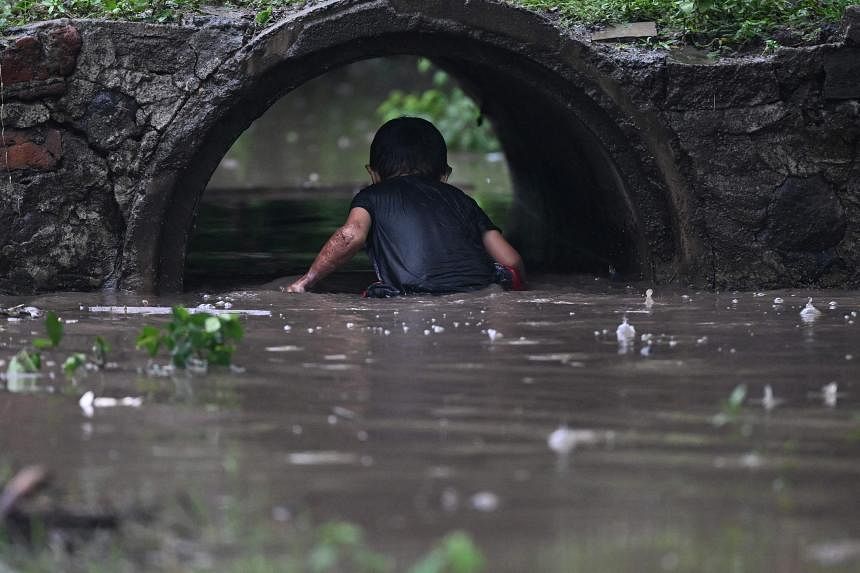NEW DELHI – When top-strength Hurricane Maria hit Puerto Rico in September 2017, bringing a big storm surge, torrential rain and howling winds, roads, bridges and the power network were obliterated.
The US island territory – which was already suffering an economic recession – came to a standstill amid electricity blackouts, severe flooding, and food and water shortages.
The US government reported the deaths of just 64 people – a figure that was soon contested by researchers.
In 2018, a randomised survey of about 3,300 households across Puerto Rico estimated deaths from the storm at 4,645 – more than 70 times higher than the official figure.
Two other studies, drawing on population registration data and the numbers of people displaced by the hurricane, put the human toll at 1,139 and 2,975 excess deaths, respectively, in the months following the disaster.
The Puerto Rico example was used by the United Nations Office for Disaster Risk Reduction (UNDRR) in a working paper in 2023 to highlight the gaps in how data related to “loss and damage” from disasters fuelled by climate change is recorded.
“Such wide-ranging estimates underline the importance of strengthening official statistics, and addressing difficulties that data experts encounter,” it noted.
Challenges to data collection often lead to underestimates of how disasters impact people and economies, UN officials and climate justice advocates told the Thomson Reuters Foundation.
They called for better data reporting systems to enable the new UN loss and damage fund, set up in December at the COP28 climate summit, to help vulnerable countries repair damage, recover from losses, and become more resilient to disasters.
Mr Harjeet Singh, global engagement director at the Fossil Fuel Non-Proliferation Treaty Initiative, said vulnerable countries should be able to get support from the UN-hosted Santiago Network to share knowledge on loss and damage, so they can produce data and develop response strategies on their own.
This, he added, is “the bedrock for the effective operation of the loss and damage fund” and will help governments overcome weak technical expertise “which severely hinders their ability to respond effectively to present and future (climate) impacts”.
Given the limitations of current databases, UNDRR is collaborating with the World Meteorological Organisation (WMO) and the UN Development Programme to create a new global “disaster losses and damages” tracking system.
It will replace the existing UNDRR disaster database, DesInventar, which mainly collects official data and is used by more than 100 governments.
The other main open-source global database on disasters, EM-DAT, is run by the Belgium-based Centre for Research on the Epidemiology of Disasters and compiles information from a range of sources, including UN agencies, aid groups and the media.
‘Revolutionary’ approach
EM-DAT gathers only national data on lives lost and numbers of people affected, whereas DesInventar allows governments to record data down to district or sub-district level and also captures economic losses and infrastructure disruptions.
The new global database aims to address limitations such as the inability to link DesInventar with other systems, differing government definitions of hazards that make cross-border comparison difficult, and a lack of specific data on vulnerable groups, said Dr Animesh Kumar, head of the UNDRR office in Bonn.
Working with the WMO will also strengthen understanding of the causes of disaster events, he said.
For example, a tropical depression tracked by the UN agency in the Bay of Bengal may evolve into a cyclone that causes a storm surge – which then leads to flash flooding.
Today each of those would be logged separately, but the new system will link them as a chain, besides recording any losses and damage they produce.
“It is a revolutionary step,” Dr Kumar said.
In addition to providing more quantified information on disasters at all scales, the new system will enable countries to monitor changes in their resilience over a longer period.
As well as covering “rapid onset” events like storms and floods, it will also track slower-occurring threats – including drought, sea-level rise and glacier melt – which have been largely overlooked but are expected to provoke significant loss and damage, including displacing people from their land.
Ms Ritu Bharadwaj, principal climate change researcher at the International Institute for Environment and Development, said many poorer countries lack the capacity to collect loss and damage data or use it to strengthen their preparedness in the face of increasingly intense and frequent climate disasters.
Governments in those countries need international financial and technical assistance to create robust data reporting and early warning systems, she added.
Dr Kumar said the new UNDRR loss and damage database would put vulnerable countries in a better position to curb the impacts of disasters through helping them understand which situations require early warning. A UN-led early-warning initiative is due to cover all countries by 2027.
Grassroots input needed
Ms Bharadwaj emphasised that grassroots organisations should be involved in gathering disaster data to provide a comprehensive assessment of loss and damage that includes the impacts on the most vulnerable and marginalised social groups.
This information will be key to supporting hard-hit communities after a disaster and helping them build back better, increasing their resilience to future threats, she added.
Mr Singh said countries that have strong local governance bodies – for example, village councils in India – should involve them in the data collection process.
Besides deepening understanding of community vulnerabilities and the different kinds of loss and damage people face, that would bring more transparency by decentralising control of data, which mostly resides with national governments, he added.
For example, when a farmer’s harvest is decimated by flooding or drought, current systems record only the monetary value of the wrecked crop, neglecting the income implications of losing seeds for the next planting season too.
Data collection practices and loss and damage assessments must also evolve to consider the so-called “non-economic” impacts of climate change, Mr Singh said.
Those include harm to people’s mental health, loss of biodiversity and the disappearance of cultural heritage and identity when communities are displaced. REUTERS

